Input interpretation

cyclopropane | melting point
Result

-128 °C (degrees Celsius)
Phase diagram

Phase diagram
Units

Unit conversions

145.2 K (kelvins)

-198.4 °F (degrees Fahrenheit)

261.3 °R (degrees Rankine)

-102.4 °Ré (degrees Réaumur)

-59.7 °Rø (degrees Rømer)
Comparisons as temperature

33.3 °C below coldest recorded temperature on Earth (-94.7 °C)

7.15 °C above Hg-Tl-Ba-Ca-Cu-oxide superconducting temperature (138 K)

20.15 °C above Tl-Ba-Cu-oxide superconducting temperature (125 K)
Corresponding quantities

Thermodynamic energy E from E = kT: | 13 meV (millielectronvolts)

Blackbody energy flux Φ from Φ = σT^4: | 25 W/m^2 (watts per square meter)

Approximate luminous exitance from a planar blackbody radiator perpendicular to its surface: | 7.8×10^-51 lx (lux)